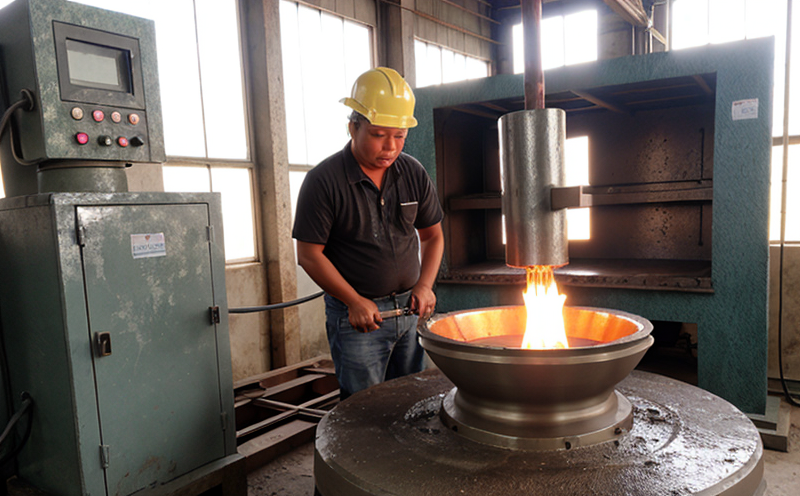ASTM B577 Detecting Discontinuities in Cast Copper Alloys
The ASTM B577 standard is a critical tool used to detect discontinuities within cast copper alloys, ensuring the integrity and quality of these materials. This method is particularly important for industries that rely heavily on the mechanical properties of copper-based materials such as aerospace, automotive, and electronics manufacturing.
Discontinuities in cast copper alloys can arise from various factors during the casting process, including improper pouring techniques, impurities, or insufficient cooling rates. ASTM B577 provides a standardized approach to identify these defects using radiographic testing (RT) methods. This technique involves exposing the specimen to X-rays or gamma rays and capturing an image of the internal structure on film or digitally.
The process begins by preparing the test sample according to ASTM B577 specifications, which include ensuring that the surface is free from contamination and that it has been properly dried before testing. Once prepared, the sample undergoes radiographic examination using either a stationary source (stationary radiography) or a mobile unit (mobile radiography). The choice of method depends on the size and complexity of the casting.
The resulting images are then evaluated for discontinuities such as porosity, shrinkage cavities, cracks, and other imperfections that could affect the mechanical integrity of the material. Each defect is classified according to its location, extent, and severity, providing a comprehensive assessment of the cast copper alloy's quality.
ASTM B577 also specifies acceptance criteria based on the American Society for Testing and Materials (ASTM) standards. These criteria ensure that only materials meeting specific requirements are approved for use in critical applications. The classification system used is detailed in ASTM B10, which provides further context on how to interpret the results of ASTM B577 testing.
By adhering to ASTM B577, manufacturers can maintain consistency and quality across production runs, reducing the risk of defects that could lead to product failures. This standardization is particularly crucial in industries where reliability and safety are paramount, such as aerospace and automotive manufacturing.
The use of ASTM B577 also facilitates compliance with international standards, ensuring that products meet global regulatory requirements. This consistency can enhance marketability and reduce the potential for disputes or rejections during export processes.
In summary, ASTM B577 is a vital tool in the detection of discontinuities within cast copper alloys. By employing this standard, manufacturers can ensure product quality, improve reliability, and maintain compliance with international standards, ultimately benefiting industries that rely on the mechanical properties of these materials.
Applied Standards
The ASTM B577 standard is specifically applied to casting copper alloys. It provides a detailed procedure for detecting discontinuities using radiographic testing methods. The application of this standard ensures that the testing process is consistent and reliable, thereby enhancing product quality.
ASTM B577 specifies the use of radiography as the primary method for identifying defects in cast copper alloys. This includes both stationary and mobile radiography techniques. The standard also provides detailed instructions on how to prepare the test samples, including cleaning, drying, and positioning them correctly for optimal results.
The acceptance criteria outlined in ASTM B577 are based on international standards such as ISO 13386-2:2019 (Non-destructive testing — Radiographic examination of castings). These criteria ensure that only materials meeting specific requirements are approved, enhancing overall product quality and reliability.
The use of ASTM B577 in conjunction with other relevant standards like ASTM B10 ensures a comprehensive approach to detecting discontinuities. This combination helps manufacturers maintain consistency across production runs, reducing the risk of defects that could lead to product failures.
Benefits
The implementation of ASTM B577 offers numerous benefits for industrial manufacturing and processing testing, particularly in casting and foundry processes. One significant advantage is the enhanced reliability and quality of cast copper alloys used in critical applications such as aerospace and automotive manufacturing.
By ensuring that only materials meeting specific requirements are approved, ASTM B577 helps manufacturers maintain consistency across production runs. This consistency reduces the risk of defects that could lead to product failures, ultimately enhancing customer satisfaction and reducing warranty costs.
The use of this standard also facilitates compliance with international standards, ensuring that products meet global regulatory requirements. This consistency can enhance marketability and reduce the potential for disputes or rejections during export processes.
In addition to improving quality and reliability, ASTM B577 helps manufacturers stay competitive by providing a standardized approach to detecting discontinuities in cast copper alloys. This standardization is particularly important in industries where reliability and safety are paramount.
The application of ASTM B577 also benefits the supply chain by ensuring that only high-quality materials are used in critical applications. This ensures that the final product meets or exceeds customer expectations, fostering long-term relationships with clients.
Industry Applications
The ASTM B577 standard is widely applicable across various industries where cast copper alloys play a crucial role due to their unique properties of strength and conductivity. Aerospace manufacturing, for instance, heavily relies on the mechanical integrity of these materials to ensure safety and performance in high-stress environments.
In the automotive industry, cast copper alloys are used in brake systems, engine components, and electrical connections, where durability and reliability are essential. By ensuring that only materials meeting specific requirements are approved through ASTM B577 testing, manufacturers can enhance the overall quality of these critical components.
The electronics sector also benefits from the use of ASTM B577 in casting copper alloys for printed circuit boards (PCBs) and connectors, where precision and conductivity are vital. The standard ensures that only high-quality materials are used, enhancing the performance and longevity of electronic devices.
Other industries, such as construction and infrastructure, also utilize cast copper alloys due to their corrosion resistance and thermal conductivity properties. ASTM B577 helps maintain consistent quality in these applications, ensuring durability and reliability in critical structures.
The use of ASTM B577 in casting and foundry processes not only enhances product quality but also supports compliance with international standards. This consistency is particularly important for companies exporting their products to various markets around the world, where adherence to global regulations is essential.





